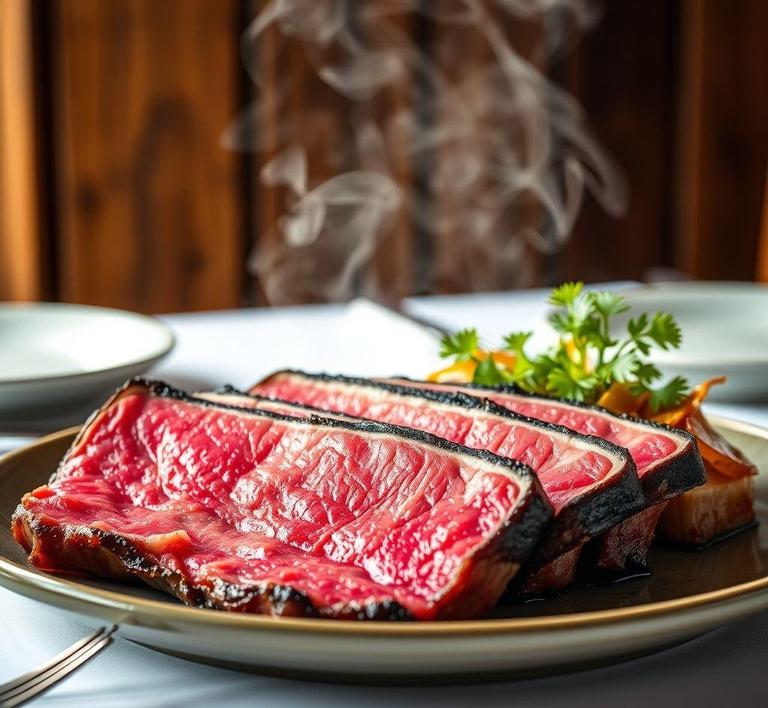Refreezing Wagyu beef can be a bit tricky, but with the right approach, you can preserve its quality and flavor for future enjoyment. Since Wagyu is known for its marbling and rich texture, it’s important to handle it properly to avoid losing those delicious qualities. Whether you’ve bought too much or just want to store leftovers, knowing how to safely refreeze this luxurious cut of meat can make all the difference. This guide will walk you through the steps to refreeze Wagyu beef without sacrificing its tender, melt-in-your-mouth goodness, so you can enjoy it at its best, even after freezing.
Can You Refreeze Wagyu Beef?

When it comes to handling premium cuts of meat like Wagyu beef, one of the most common questions home cooks and steak enthusiasts ask is whether or not it’s safe to refreeze it. Wagyu beef, known for its rich marbling, buttery texture, and exceptional flavor, is a high-end product, so naturally, you want to treat it with the utmost care.
Technically speaking, it is possible to refreeze Wagyu beef, but whether you should is another matter entirely. The process of freezing and thawing meat is often a delicate dance. When you freeze meat, water inside the muscle fibers expands and forms ice crystals. When the meat thaws, the ice crystals melt, potentially damaging the meat’s texture by breaking down cell walls. If you refreeze the meat after it has thawed, the cycle of freezing and thawing can result in a loss of moisture, tenderness, and, ultimately, the Wagyu’s famed melt-in-your-mouth quality.
For Wagyu beef, where texture and marbling are key to its enjoyment, refreezing is generally not recommended unless it’s absolutely necessary. This is especially true if the beef has been thawed improperly or has been sitting in the fridge for a while. However, in some situations where refreezing may be unavoidable, it can still be done safely, provided the beef has been thawed in the refrigerator and not at room temperature.
How To Refreeze Wagyu Beef?
If you find yourself in a situation where refreezing Wagyu beef is the only option, you’ll want to approach it carefully to minimize any negative effects on its quality. Here’s a step-by-step guide on how to safely refreeze Wagyu beef:
-
Thaw Properly
First and foremost, it’s essential to thaw the Wagyu beef in the refrigerator, not on the counter. Slow and steady thawing is key to preserving the meat’s texture. If the beef has been thawed at room temperature, it may already be at risk of bacterial growth, which could compromise both its safety and quality when refrozen.
-
Check for Freshness
Before refreezing, take a moment to inspect the beef. If it has been thawed for several days and shows signs of deterioration-like an off odor, discoloration, or slimy texture-it’s best to avoid refreezing altogether.
-
Wrap it Well
Proper packaging is crucial when refreezing Wagyu beef. Wrap the meat tightly in plastic wrap or butcher paper to prevent exposure to air. You can also place it in a vacuum-sealed bag, which will ensure that no air comes into contact with the meat, preventing freezer burn.
-
Label and Freeze
Once it’s securely wrapped, label the package with the date so you can keep track of how long the meat has been frozen. The longer meat stays in the freezer, the more it loses in quality, so aim to use the refrozen Wagyu beef within a month.
-
Avoid Multiple Thawing Cycles
If possible, try not to refreeze Wagyu beef multiple times. Each freeze-thaw cycle will further deteriorate its quality, so it’s best to avoid this unless absolutely necessary.
Quality Impact
Wagyu beef is a meat that is often celebrated for its tenderness, unique flavor, and melt-in-your-mouth texture, largely due to its high fat content and intricate marbling. Freezing and refreezing this delicate cut can have noticeable impacts on its quality.
-
Loss of Moisture
When Wagyu beef is frozen and then thawed, the water within the meat forms ice crystals. The freezing process damages the structure of muscle fibers, causing them to lose moisture when thawed. This moisture loss is less noticeable in lower-quality cuts but can be very detrimental to the superior texture of Wagyu. As a result, the meat may dry out slightly and lose some of its luxurious tenderness.
-
Fat Integrity
The marbling in Wagyu beef is what sets it apart from other meats, contributing to its tender, juicy texture and flavor. Freezing and thawing can cause some of the fat to break down or become grainy. When refrozen, some of the fat may lose its silky texture, leading to a less rich mouthfeel.
-
Flavor Deterioration
While freezing doesn’t typically alter the overall flavor of meat drastically, the changes in texture-particularly the loss of moisture-can make the meat less pleasant to eat. If the beef becomes too dry or tough after refreezing, the signature flavor profile of Wagyu might be dulled.
-
Freezer Burn
One of the risks of freezing Wagyu beef improperly (or refreezing it) is freezer burn. This occurs when the meat is exposed to air in the freezer, leading to dehydration and oxidation. The result is dry, discolored, and unpleasant-tasting meat. To prevent freezer burn, ensure that the Wagyu beef is wrapped tightly and that there’s no air in contact with the surface of the meat.
While refreezing won’t destroy Wagyu beef outright, it can certainly impact its quality. The texture and marbling that make Wagyu so desirable may suffer, diminishing the experience of eating this luxurious cut of meat.
While it’s technically possible to refreeze Wagyu beef, it’s not something you should do lightly. If you have no choice but to refreeze it, following proper techniques can help minimize quality loss, though it’s always preferable to cook and consume Wagyu within a short time frame after thawing. The freezing and thawing process inevitably affects the texture, flavor, and fat content of this high-end meat, potentially diminishing the very qualities that make Wagyu so special.
So, if you’re planning to purchase or store Wagyu beef, consider freezing it only once to maintain its luxurious texture and mouthwatering flavor. And if you find yourself with a cut that has already been thawed, make sure to use it soon to avoid the need for refreezing altogether. With a little care and attention, you can still enjoy a deliciously rich steak, but when it comes to Wagyu beef, a fresh cut is always the best choice for preserving its iconic quality.
Is It Safe To Refreeze Wagyu Beef?
Wagyu beef is renowned for its exceptional quality, delicate marbling, and rich flavor profile. As a luxury ingredient, it commands special attention when it comes to storage and handling. When it comes to the question of whether it’s safe to refreeze Wagyu beef, the short answer is, "It depends." Let’s unpack this further.
Refreezing meat, in general, is a bit of a culinary gamble because of how freezing and thawing can impact texture and safety. When meat is frozen, ice crystals form inside the cells, and upon thawing, those crystals can rupture the cell walls, causing moisture loss. When you refreeze the beef, these effects can compound, resulting in a drier, less flavorful cut of meat. For Wagyu, this can be even more problematic since the prized marbling (intramuscular fat) is what gives it its signature tenderness and rich taste. Refreezing could cause the fat to degrade, impacting both texture and flavor.
That said, refreezing Wagyu beef is generally safe from a food safety perspective if it has been thawed properly and kept at a safe temperature (below 40°F or 4°C). The key factor here is whether the meat has been exposed to any temperature danger zones during thawing or storage. If, for example, Wagyu beef has thawed at room temperature for more than two hours, it may have entered the ‘danger zone’ (between 40°F and 140°F), which allows bacteria to grow rapidly, making the beef unsafe to consume.
In summary, while refreezing Wagyu is safe if handled correctly, it’s worth considering whether the trade-off in texture and flavor is worth it. If the beef was thawed in the refrigerator and not left out at room temperature, it should be safe to refreeze, though the overall quality may suffer with each freeze-thaw cycle.
Signs That Wagyu Beef Should Not Be Refrozen
While it’s possible to refreeze Wagyu beef under the right conditions, there are certain signs you should look out for that indicate the beef should not be refrozen. These signs are primarily related to food safety, but they can also be tied to the deterioration of the meat’s quality.
- Off-Putting Smell: One of the most important indicators that Wagyu beef shouldn’t be refrozen is a foul, sour, or rancid odor. This is a sign of bacterial growth or spoilage. If you notice any unpleasant smell, discard the beef immediately. Wagyu beef should have a clean, fresh scent, indicative of its high quality.
- Discoloration: If the beef has developed an unnatural color-like brown or grayish hues-especially after thawing, it could indicate that the meat has begun to spoil. Healthy Wagyu beef should have a vibrant, deep red color with visible marbling of white fat. Any signs of discoloration may suggest the onset of microbial activity.
- Slimy Texture: Another red flag is a slimy or tacky texture on the surface of the beef. When meat becomes slimy, it’s usually a sign that bacteria or other microorganisms have started to break it down. This sliminess, often caused by moisture loss or microbial contamination, is a sign that the beef is no longer safe to consume.
- Extended Thaw Time: If Wagyu beef has been thawed for more than 24 hours in the refrigerator (or more than two hours at room temperature), the chances of bacterial growth are much higher. If there’s any suspicion that the meat has spent too long outside of the safe temperature range, it’s best not to refreeze it.
- Leaking Liquids: While thawing, some liquid might naturally escape from the beef, but an excessive amount of liquid (especially if it looks milky or has an off odor) is a red flag. This indicates that the beef is starting to break down and may be unsafe to refreeze.
Common Refreezing Mistakes
When dealing with Wagyu beef, there are several common mistakes that can diminish the quality or safety of the meat during refreezing. Here are a few to keep in mind:
- Thawing at Room Temperature: One of the most frequent mistakes is thawing meat at room temperature. This accelerates bacterial growth and can cause the beef to spoil more quickly. It’s essential to thaw Wagyu beef in the refrigerator, not on the counter. If you need to speed up the thawing process, submerge the vacuum-sealed pack in cold water.
- Refreezing Multiple Times: The more times you freeze and thaw meat, the more the quality will degrade. Each cycle leads to further breakdown of muscle fibers, fat, and moisture, resulting in dry, tough, and less flavorful meat. Avoid refreezing Wagyu more than once, and if you must, try to consume it as soon as possible after thawing.
- Improper Packaging: If Wagyu beef is not sealed correctly, it can develop freezer burn, which not only impacts the appearance and texture but also the flavor. Always ensure the beef is wrapped tightly in plastic or vacuum-sealed before freezing to prevent air exposure. If you’re refreezing, make sure to remove any air pockets from the packaging.
- Refreezing Partially Thawed Meat: If Wagyu beef is thawed partially but still frozen in parts, it’s a mistake to refreeze it. When you refreeze partially thawed meat, it can create uneven freezing, which further damages the texture and safety of the beef. It’s important that the beef is either fully frozen or fully thawed before considering refreezing.
- Not Labeling the Beef: A simple but critical mistake is forgetting to label frozen beef with the date it was originally frozen or thawed. Without this information, it’s hard to gauge how long the meat has been frozen or thawed, which increases the risk of keeping it too long, causing degradation in both safety and quality.
Tips And Tricks
- Use a Meat Thermometer: Ensure that your Wagyu beef is kept at safe temperatures throughout the thawing and refreezing process. A meat thermometer can help ensure that the internal temperature of the meat never rises above 40°F (4°C) during thawing, and that it returns to a safe temperature if refrozen.
- Vacuum Sealing: Vacuum sealing is one of the best ways to preserve the quality of Wagyu beef while freezing. Not only does it minimize exposure to air (which leads to freezer burn), but it also locks in moisture, ensuring that the meat stays as fresh as possible.
- Portion Control: If you know you won’t be able to eat the entire cut of Wagyu beef in one sitting, consider portioning it out before freezing. This way, you can thaw only what you need and avoid the temptation to refreeze the entire portion.
- Rapid Thawing: If you’re in a hurry to thaw the beef, consider using a cold water bath. Place the vacuum-sealed pack of meat in a bowl of cold water (not warm, as that could cause bacterial growth). This method can defrost the meat more quickly and safely than simply leaving it out at room temperature.
- Quality Inspection After Thawing: When thawing Wagyu beef, always inspect the meat for any changes in texture, smell, or appearance. This can help you identify any issues early before you make the decision to refreeze.
Conclusion
Refreezing Wagyu beef is a decision that requires careful consideration. While it is technically safe to refreeze the beef if it has been handled properly-maintained at the right temperature and thawed safely-it is important to be aware of how refreezing can impact its luxurious texture and flavor. The key to preserving the quality of Wagyu is minimizing the number of freeze-thaw cycles it undergoes and taking great care in how it’s stored.
By following proper thawing procedures, avoiding common mistakes like thawing at room temperature, and knowing the signs that the beef has gone bad, you can ensure that your Wagyu beef remains a true indulgence even if it’s refrozen. When in doubt, the best approach is to only freeze what you plan to use within a reasonable timeframe, to ensure that you get the full experience of its unparalleled tenderness and flavor.


